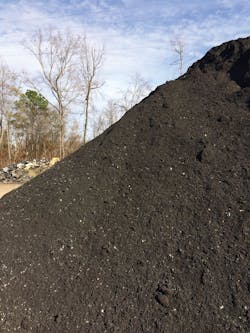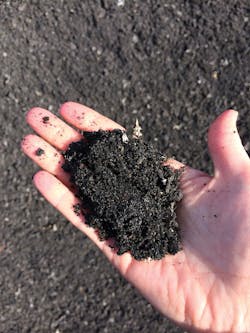Loose binder
The use of reclaimed asphalt shingles (RAS) in asphalt mixes is on the rise.
A recent survey conducted by the National Asphalt Pavement Association (NAPA) showed that RAS use reached 1.9 million tons nationwide in 2014, an increase of nearly 180% since 2009. While reducing material costs for asphalt mixes is a driving factor in the use of RAS, it’s also a matter of sustainability. Not only does RAS use conserve raw materials, but it also resolves waste disposal issues and reduces the amount of shingles dumped in landfills.
RAS contains asphalt binder, organic fibers or fiberglass, mineral aggregate and mineral filler. Once ground, it can be added directly to asphalt mixes or renewed with rejuvenating chemicals prior to the mix process. RAS is available from two distinct sources: manufacturing waste (MW) and post-consumer (PC) waste. PC RAS is more commonly used in asphalt mixes because of its greater availability. It typically contains more deleterious materials than MW RAS and has higher asphalt content that is due to weathering of the surface granules. PC RAS stockpiles also tend to exhibit more variability in size, aggregate gradation and asphalt content, as well as material properties such as specific gravity.
Because shingles are air-blown, RAS binder is stiffer and has different rheological properties than virgin or modified binders. The addition of RAS has been shown to improve the rutting resistance of asphalt pavements, but there is concern about long-term durability of RAS mixes. If the stiffness of RAS binder is not considered in mix design, it can negatively influence fatigue and thermal-cracking performance.
Many state agencies limit the amount of RAS in asphalt mixes—typically 5% or less by weight of the aggregate. Other states have specifications that limit the percentage of recycled binder. In either case, successful RAS mixes depend on correct processing and handling of the RAS material, which is detailed in NAPA’s recent publication, Best Practices for RAP and RAS Management (available as a free download at asphaltpavement.org).
Mixes containing RAS must be properly designed in order to be cost-effective and to ensure good mix performance. AASHTO PP 78, Design Considerations When Using Reclaimed Asphalt Shingles (RAS) in Asphalt Mixtures, requires the performance grade (PG) of the RAS binder in order to complete blending charts used to determine the correct virgin binder grade for use in mix design. Yet many states do not require performance grading of the RAS binder because of the challenges involved in RAS binder characterization. Recovered RAS binders are difficult to work with because of their extreme stiffness at normal binder handling temperatures and the small mold shapes required for some binder testing. Additionally, common dynamic shear rheometer (DSR) models using water baths for temperature control cannot be used to directly assess the high-temperature grade of the RAS binder since many RAS binders have critical high temperatures above the boiling point of water. The creation of test specimens for low-temperature testing also is difficult because recovered RAS binders are extremely brittle. Despite potential handling and testing difficulties, it is important that blended RAS and virgin binder meets the same performance criteria as virgin binder in terms of binder grade, strength and durability.
The high and the low
The National Center for Asphalt Technology (NCAT) recently conducted a study investigating methods of characterizing RAS binder for both critical high and low temperatures. In addition to direct measurement, extrapolation methods also were evaluated, as many contractors and states do not have equipment capable of directly measuring the actual high- and low-temperature performance grades of RAS binder. Testing involved both PC and MW RAS samples from different geographic regions across the U.S.
To obtain RAS binder samples, the centrifuge extraction method (ASTM D2172-05 Method A) was used with trichloroethylene (TCE) as the solvent, followed by the rotary evaporator recovery procedure (ASTM D5404-03). Because of the high viscosity of the recovered RAS binder, it was necessary to increase the drain time and temperature used for removing the recovered binder from the recovery flask. For high-temperature testing, three extraction/recovery procedures were performed for each RAS source so that between-sample variability could be quantified as well as within-sample variability. As a result of material and time limitations, only one extraction/recovery procedure was performed for each RAS source used for low-temperature testing, so between-sample variability at cold temperatures was not evaluated.
The recovered RAS binders were tested in accordance with the procedures described in AASHTO M320-10, AASHTO R29-08 and ASTM D7643-10 to determine high- and low-performance grades as well as continuous grading temperatures. There is no official guidance regarding the aging of RAS binders, but an attempt at aging-recovered RAS binder in the rolling thin-film oven (RTFO) showed that the viscosity of the RAS binder was too high and that it did not move in the bottles during the procedure. Therefore, the RAS binders for this study were tested in their as-recovered state with no additional aging. Short-term and long-term aging of RAS binders in the RTFO and pressure-aging vessel (PAV) are considered redundant because RAS is already aged because of the air-blown shingle manufacturing process. PC RAS is further aged while in-service. Both of these aging conditions are more severe than the RTFO and PAV.
The high-temperature properties of the RAS binders were measured using a DSR model with the capability of testing at temperatures up to 150°C using a heated upper plate assembly. For higher temperatures, an environmental temperature chamber assembly with a liquid nitrogen purge was used. The temperatures necessary to achieve a failing high-temperature result for RAS binder often exceed the temperature range of some DSR models, so it is sometimes necessary to extrapolate by 50-60°C or more to determine the continuous grading temperature. For the extrapolation method, three samples from each extraction were tested at 82, 88 and 94°C, the highest standard test temperatures that a water-controlled DSR is able to maintain. The resulting values of G*/sin(δ) were plotted versus temperature on a log scale and extrapolated to a value of 2.20 kPa, the critical high-temperature criteria.
Low continuous grading temperatures were determined using two test procedures. Testing with the bending beam rheometer (BBR) presented some challenges that made it difficult to obtain reliable results. Not only was it difficult to prepare test specimens because of the high viscosity of the RAS binder and the small dimensions of the BBR sample mold, but the poor relaxation properties of the RAS binder made the test specimens brittle at colder temperatures and prone to breakage when the test load was applied. Thus, BBR testing was performed at the two warmest standard test temperatures possible: +6 and 0°C. The test results were then extrapolated to values of S(60) = 300 MPa and m(60) = 0.300 to determine the low continuous grading temperatures based on BBR criteria. The second method used to determine low continuous grading temperatures was developed by Western Research Institute (WRI). The 4-mm plate DSR procedure provides a method for estimating BBR S(t) and m(t) values that eliminates the need to mold test specimens and allows for testing at warmer temperatures than can be achieved in the BBR bath.
Other methods should be considered for extrapolation of critical high and low temperature grades for RAS binders.
Critical condition
Critical high-temperature grades were directly measured for three PC RAS sources (Michigan, New Hampshire and Georgia), two MW RAS sources (Michigan and Texas), and a blend of MW and PC RAS from Oregon. Three extractions were performed for each source, and three replicate tests were performed on recovered RAS binder from each extraction, resulting in nine individual data points for each source.
Within-sample critical high-temperature grades were less variable than between-sample critical high-temperature grades for a given RAS source. In order to normalize the within-sample standard deviations, the data was transposed on a log scale. Based on a 95% confidence interval, one would expect the results of three critical high temperatures within a sample to vary between 0.9 and 2.4°C. The standard deviations for between-sample tests had a normal distribution and ranged 4.6-12°C.
The linear extrapolation method previously described also was used to determine critical high-temperature grades for each of the six RAS sources. The extrapolated critical binder high-temperature grades were statistically the same as tested results. However, scatterplots showed practical differences between the measured and extrapolated data. Using averages of triplicate test results reduced variability and disagreement. Thus, care should be taken to reduce variability when extrapolating critical high temperatures of RAS binder. Outliers should be removed, and an average of triplicate results should be taken to ensure more precise and accurate results.
Critical low-temperature grade testing was performed on four RAS sources: Texas MW, Wisconsin MW, Oregon MW/PC blend and New Hampshire PC. Only one extraction procedure was performed for each RAS source as a result of material and time limitations. It should be noted that these test results and conclusions were based on limited data acquired using very challenging test procedures.
Both BBR and DSR low-temperature testing provided variable and inconsistent critical low temperatures for RAS binder. The critical low temperatures based on both BBR S(60) and m(60) criteria had coefficients of variation (COV) ranging from 12.1% to 293%, while the COV for the DSR S(60) and m(60) results ranged from 32.7% to 163.7%. No statistical differences were found between the measured and extrapolated results for almost all of the RAS samples as well as the entire population. However, scatterplots showed a lack of correlation between the two methods for either criterion. Because of the complex nature of RAS binders, it is difficult to determine which test provides the most accurate result. This area needs additional work—perhaps the development of a new testing method for determining the low-temperature properties of RAS binder.
Other methods should be considered for extrapolation of critical high and low temperature grades for RAS binders. Currently, the Asphalt Institute is working on developing and quantifying the variability of other extrapolation/blending methods using the same materials applied in this study.

